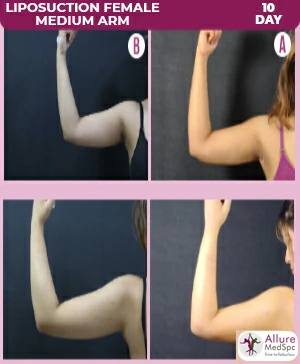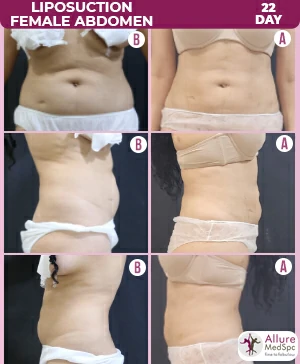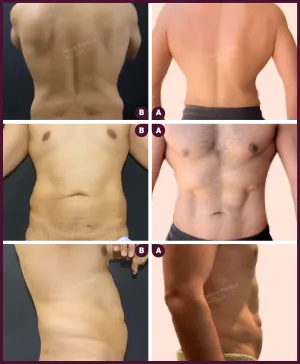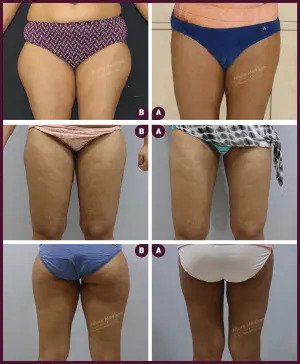Water-Jet Liposuction: Gentle, Safe & Precise Body Contouring with Expert Care in Mumbai
Introduction to Water-Jet Liposuction Surgery
- Are you struggling with stubborn fat that won’t budge despite strict dieting and exercise?
- Do you feel uncomfortable in fitted clothes because of bulges on your tummy, thighs, or arms?
- Are you looking for a gentler, safer liposuction technique that minimizes trauma, bruising, and downtime?
Excess localized fat doesn’t just affect your body shape—it often impacts your confidence, social presence, and how you feel in your own skin. Traditional fat removal techniques may sometimes feel aggressive, leaving patients worried about pain, swelling, or recovery.
Water-Jet Liposuction Surgery offers a hopeful, advanced solution. This innovative technique uses a controlled, pressurized stream of saline to gently loosen fat cells before suction. By softening the fat first, the procedure allows for smoother removal, reduced tissue trauma, and faster recovery. It’s especially beneficial for patients seeking natural-looking contouring with less discomfort and downtime.
Global & Indian Statistics (ISAPS 2023)
- 2,798,597 liposuction procedures were performed worldwide in 2023, making it the most popular cosmetic surgery. (ISAPS Global Survey 2023)
- India contributed over 95,000 liposuction surgeries in 2023, with modern methods like Water-Jet Liposuction gaining attention for being minimally traumatic.
Let’s explore how Water-Jet Liposuction works, its advantages over traditional methods, and why more patients are choosing this technology for safe and precise body sculpting.
What is Water-Jet Liposuction Surgery?
Water-Jet Liposuction is a minimally invasive fat removal technique that uses a high-pressure saline spray to gently loosen fat cells, which are then suctioned out through a hollow cannula. By hydrating and dislodging the fat before extraction, the procedure minimizes damage to surrounding tissues, reduces bruising, and promotes quicker recovery.
Synonyms of Water-Jet Liposuction Surgery
- Body-Jet Liposuction
- Hydro Liposuction
- Water-Assisted Liposuction (WAL)
- Hydro-Jet Body Contouring
- AquaLipo Surgery
Water-jet (WAL) lipo uses a pulsed saline jet to loosen fat; simultaneous suction removes it via tiny incisions with minimal tissue trauma.
- Tumescent/Wetting Solution: Saline with anesthetic is delivered through the cannula to numb and reduce bleeding.
- Pulsed Saline Jet: A fan-shaped, pressurized jet gently separates fat cells from surrounding tissues.
- Simultaneous Aspiration: The cannula’s second channel suctions the loosened fat as it’s dislodged.
- No Thermal Energy: Mechanical hydro-dissection lowers burn risk and helps limit bruising/swelling.
- Tiny Incisions: Small, well-hidden entry points aid faster recovery and smoother contours.
- Ideal for Grafting: Gentle handling can preserve fat-cell viability for transfer when indicated.
- Expert Oversight: Dr. Milan Doshi customizes jet pressure, flow, and passes to match your anatomy and goals.
Water-Jet lipo gently loosens fat with a pulsed saline jet—less trauma and bruising, higher precision, better graft quality, and faster recovery.
- Gentle Hydro-Dissection: Pulsed saline separates fat with minimal tissue damage, pain, and bruising.
- No Heat Damage: Non-thermal technique protects skin, vessels, and collagen.
- Precision Sculpting: Fine control around nerves, septa, and delicate zones.
- Simultaneous Infiltration + Suction: Efficient removal with cleaner operative fields.
- High Graft Viability: Fat handled gently—ideal for BBL or breast fat grafting.
- Faster Recovery: Less swelling and downtime; earlier return to routine.
- Revision-Friendly: Useful in secondary cases or scarred/fibrous areas.
- Expert Oversight: Dr. Milan Doshi tailors jet pressure, flow, and passes for safe, natural results.
Water-jet lipo uses two fluids: a tumescent mix (saline + lidocaine + epinephrine, ± bicarbonate) and a plain saline jet for gentle fat separation.
- Tumescent/Wetting Solution:
– Saline (0.9%) – diluent and tissue hydration
– Lidocaine – local anesthetic for pain control
– Epinephrine – vasoconstrictor to reduce bleeding/bruising
– Sodium bicarbonate (optional) – buffers acidity to lessen sting - Irrigating/Jet Fluid: Plain isotonic saline used to gently hydro-dissect fat with minimal thermal trauma.
- Why Two Fluids? Analgesia + hemostasis from tumescent mix; smooth separation from saline jet for cleaner aspiration.
- Expert Oversight: Dr. Milan Doshi tailors concentrations, volumes, and flow to your anatomy and safety.
Ideal candidates have small–moderate stubborn fat, good skin tone, stable weight, and realistic goals—confirmed during a surgeon consultation.
- Localized Fat: Pockets that resist diet and exercise.
- Skin Quality: Mild–moderate laxity; marked laxity may need WAL + RF/J-Plasma.
- Stable Weight: Near ideal BMI; not a weight-loss procedure.
- Overall Health: No uncontrolled medical conditions; medications reviewed.
- Lifestyle: Non-smoker (or willing to pause) and able to follow aftercare.
- Fat Grafting Plans: WAL’s gentle handling supports high-quality grafts (BBL/breast).
- Revision Friendly: Helpful in secondary cases or scarred areas.
- Expert Assessment: Dr. Milan Doshi tailors candidacy and plan to your goals and anatomy.
WAL gently contours the abdomen, thighs, arms, flanks, back, chest, and chin/neck using a pulsed saline jet with minimal tissue trauma.
- Abdomen & Waist: Smooths belly fullness and refines the waistline.
- Flanks/Love Handles: Reduces side bulges for a balanced silhouette.
- Thighs (Inner/Outer): Targets saddle bags and inner-thigh rubbing.
- Arms: De-bulks upper arms for a toned appearance.
- Back & Bra Rolls: Flattens upper/mid-back bulges under clothing.
- Chest (Male): Assists contouring when clinically appropriate.
- Chin, Neck & Jawline: Refines double chin and sharpens definition.
- Hips & Banana Roll: Improves hip dips and the fold beneath the buttock.
- Knees: Slims inner knee fullness for a streamlined leg line.
- Calves/Ankles: Select cases for lower-leg sculpting.
- Expert Planning: Dr. Milan Doshi tailors WAL zones and settings for safe, natural results.
Water-Jet lipo uses a pulsed saline jet via tiny incisions to loosen fat and suction it out, reducing trauma and enabling a faster recovery.
- Marking & Planning: Treatment zones mapped to guide precise contouring.
- Anesthesia: Local or general anesthesia for comfort and safety.
- Tumescent/Wetting: Dilute anesthetic with epinephrine is infused to numb tissue and limit bleeding.
- Tiny Incisions: Small, hidden entry points created for the WAL cannula.
- Pulsed Saline Jet: Dual-lumen cannula delivers a fan-shaped saline jet to gently hydro-dissect fat.
- Simultaneous Aspiration: Loosened fat is suctioned through the cannula’s second channel.
- Controlled Passes: Surgeon adjusts jet pressure/flow and uses fanning strokes for even removal.
- Contour Check: Palpation and visual assessment ensure smooth, symmetrical results.
- Hemostasis & Closure: Minimal bleeding; micro-incisions usually closed with tapes or a stitch.
- Compression Garment: Applied to reduce swelling and support new contours.
- Recovery Guidance: Early ambulation, garment schedule, and aftercare explained.
- Optional Fat Grafting: Gently harvested fat may be refined and transferred if planned.
- Expert Oversight: Dr. Milan Doshi customizes settings to your anatomy for safe, natural results.
Results appear immediately; major improvement at 1 month, refining over 3–6 months. Skin tightening continues for 6–9 months.
- Immediate: Noticeable contour change right after surgery.
- Days 1–3: Mild soreness and swelling; wear compression as advised.
- 1–2 Weeks: Bruising fades; daily activities feel easier.
- 1 Month: Major improvement in shape and definition.
- 3–6 Months: Results refine as tissues settle and swelling resolves.
- 6–9 Months: Gradual skin tightening and texture improvement.
- Expert Insight: Dr. Milan Doshi’s aftercare plan helps maintain smooth, natural results.
Results appear immediately; major improvement at 1 month, refining over 3–6 months. Skin tightening continues for 6–9 months.
- Immediate: Noticeable contour change right after surgery.
- Days 1–3: Mild soreness and swelling; wear compression as advised.
- 1–2 Weeks: Bruising fades; daily activities feel easier.
- 1 Month: Major improvement in shape and definition.
- 3–6 Months: Results refine as tissues settle and swelling resolves.
- 6–9 Months: Gradual skin tightening and texture improvement.
- Expert Insight: Dr. Milan Doshi’s aftercare plan helps maintain smooth, natural results.
Light activity in 2–3 days, swelling down in 1–2 weeks, most recovery by 3–4 weeks; contours refine for 3–6 months.
- First 24–48 Hours: Mild soreness and swelling; start short walks and wear compression garment as advised.
- 2–3 Days: Resume light daily tasks or desk work if comfortable; avoid heavy lifting.
- 1 Week: Bruising begins to fade; discomfort markedly improves.
- 1–2 Weeks: Most swelling subsides; normal mobility returns for routine activities.
- 3–4 Weeks: Gradually restart moderate exercise; majority of recovery completed.
- 3–6 Months: Ongoing refinement as tissues settle and edema resolves.
- Expert Tip: Dr. Milan Doshi’s tailored aftercare—garments, activity pacing, and massage—helps optimize smooth, natural results.
Water-Jet lipo is generally safe; temporary swelling/bruising are common. Rare risks include seroma, infection, numbness, or contour irregularities.
- Swelling & Bruising: Common in the first 1–2 weeks; improves with compression.
- Soreness/Discomfort: Usually mild; managed with prescribed analgesics.
- Seroma: Fluid collection; treated with compression or aspiration if needed.
- Infection: Rare; minimized by sterile technique and antibiotics.
- Numbness/Tingling: Temporary nerve irritation that resolves over weeks.
- Hematoma/Bleeding: Uncommon; careful hemostasis reduces risk.
- Contour Irregularities: Over/under-correction possible; even passes and aftercare help.
- Skin Laxity Persistence: WAL offers limited tightening; RF/J-Plasma may be advised.
- Tiny Scars: Small entry points, typically discreet once healed.
- Expert Safety: Dr. Milan Doshi follows NABH-grade protocols to reduce complications.
Water-jet lipo is gentle but slower, best for small–moderate volumes. Skin-tightening is limited; large or fibrous areas may need combo techniques.
- Smaller Volume per Session: Less efficient for massive debulking compared with PAL/VASER.
- Time-Consuming: Hydro-dissection and fluid management can extend OR time.
- Limited Tightening: Minimal skin contraction; often paired with RF or J-Plasma for firmness.
- Fibrous Fat Challenge: Dense areas (e.g., male chest, back) may respond better to VASER/PAL.
- Cost & Logistics: Specialized device and longer operative time can raise overall cost.
- Best Use Case: Gentle harvesting preserves fat viability for grafting but trades speed.
- Expert Strategy: Dr. Milan Doshi tailors WAL alone or in combination to match goals and safety.
In Mumbai, Water-Jet lipo cost varies by area treated, anesthesia, facility, tech, and surgeon skill; an exact estimate is given after consultation.
- Advanced Technology: Water-assisted (WAL/Body-Jet) platform adds precision and gentleness.
- Surgeon Expertise: Fees reflect board-certified skill; Dr. Milan Doshi oversees planning and safety.
- Areas & Volume: Single vs multiple zones, 360° contouring, and fat volume change pricing.
- Anesthesia & OR Time: Local vs general and operative duration affect overall cost.
- Facility Standards: NABH-compliant theatre, monitoring, and emergency backup add safety value.
- Add-Ons: Combo techniques (PAL/VASER/RF/J-Plasma), fat grafting, garments, meds, and follow-ups.
- Transparent Quote: Itemized estimate provided after clinical evaluation and goal setting.
Dr. Milan Doshi is Mumbai’s board-certified expert in Water-Jet liposuction, with 25+ years’ experience and 3,000+ cases for safe, natural results.
- Board-Certified Expertise: Indian Board–certified Cosmetic & Plastic Surgeon.
- Extensive Experience: 25+ years with 3,000+ liposuction cases, including Water-Jet (WAL).
- Gentle, Precise Technique: Hydro-dissection preserves tissues for smoother recovery.
- Comprehensive Sculpting: Can combine WAL with PAL/VASER or fat grafting when appropriate.
- Safety-First Facility: NABH-compliant OT, qualified anesthesia team, life-support backup.
- Patient-Centric Care: Transparent counseling, tailored plans, discreet aftercare.
Allure Medspa, led by Dr. Milan Doshi, is NABH-compliant with advanced tech, overnight facility, and discreet, patient-first care for Water-Jet lipo.
- NABH Certified: Stringent surgical protocols, sterile OT, and audited safety systems.
- Advanced Equipment: Modern life-support and monitoring for added safety.
- Overnight Facility: Comfortable stay with close post-op supervision.
- Expert Leadership: Indian Board–certified Dr. Milan Doshi oversees planning and surgery.
- Privacy & Confidentiality: Discreet pathways, secure records, and respectful care.
- Patient-Centric: Transparent counseling, tailored plans, and structured aftercare.
- Convenient Location: Modern centre in Goregaon West, Mumbai.
ICD-10 Codes for Water-Jet Assisted Liposuction
| ICD-10 Code | Description |
|---|---|
| E65 | Localized adiposity (localized fat deposits in abdomen, thighs, arms, chin, etc.) |
| L98.7 | Excessive and redundant skin and subcutaneous tissue (skin laxity after fat accumulation) |
| M95.8 | Other specified acquired deformities of musculoskeletal system (contour irregularity) |
| E66.9 | Obesity, unspecified (when indicated for body contour correction in obese patients) |
| Z41.1 | Encounter for cosmetic procedure (elective aesthetic liposuction) |
CPT Codes for Water-Jet Assisted Liposuction
| CPT Code | Description |
|---|---|
| 15877 | Suction-assisted lipectomy; trunk (abdomen, flanks, back) |
| 15878 | Suction-assisted lipectomy; upper extremity (arms) |
| 15879 | Suction-assisted lipectomy; other areas (thighs, calves, buttocks, neck, chin) |
| 15876 | Suction-assisted lipectomy; head and neck (double chin/jawline) |
| 17999 | Unlisted procedure, skin, mucous membrane, and subcutaneous tissue (used when specifying water-jet technology since no unique CPT exists for WAL) |
| 15771 | Autologous fat grafting, by liposuction technique, 50 cc or less (if harvested WAL fat is re-injected for contouring) |
| 15772 | Each additional 50 cc injected (add-on code for grafting) |
Q1. Is Liquid Lipo safe for the stomach?
Ans. Yes, when performed by a certified cosmetic surgeon, Liquid Lipo (Water-Jet Liposuction) is safe for abdominal fat removal with minimal tissue trauma.
Q2. How many sessions of Liquid Lipo are needed to see results?
Ans. Most patients require only one session per targeted area. However, additional sessions may be advised for large-volume fat removal or fine-tuning.
Q3. Do you lose weight with Liquid Liposuction?
Ans. Water-Jet Liposuction targets inch loss and contouring rather than weight loss. It reshapes the body by removing stubborn localized fat.
Q4. What is the most effective liposuction method?
Ans. Water-Jet (WAL) is considered one of the safest and gentlest options for fat removal, especially for delicate areas or patients opting for fat grafting.
Q5. Do you pee out lipo fluid?
Ans. Yes, the fluid used during the procedure is gradually absorbed or excreted via the kidneys and lymphatic system post-procedure.
Q6. Is Water Lipo safe?
Ans. Absolutely. It uses a pulsating jet of saline to loosen fat without damaging blood vessels or nerves, ensuring higher safety and less bruising.
Q7. Do you leak after liposuction?
Ans. Mild fluid leakage from the incision sites is common for 24–48 hours post-surgery. It’s normal and helps drain excess tumescent fluid.
Q8. How many kg of fat can be removed in one liposuction session?
Ans. Typically, 4–6 liters (around 4–6 kg) of fat can be safely removed, depending on the patient’s body type and surgeon’s discretion.
Q9. Is Liquid Lipo permanent?
Ans. The fat cells removed are permanently gone. However, future weight gain can expand remaining fat cells if lifestyle changes aren’t maintained.
Q10. How long do I leak after liposuction?
Ans. Fluid drainage may last for 1–2 days post-surgery and is part of the healing process. Wearing compression garments can help reduce leakage.
Q11. How to sleep after liposuction?
Ans. Sleep on your back with elevated legs using pillows for support. Avoid sleeping on the treated areas for the first few days to prevent discomfort.
Q12. Do you bleed a lot after liposuction?
Ans. Bleeding is minimal in Water-Jet Liposuction due to its gentle technique and use of tumescent fluid that constricts blood vessels.
Q13. Will there be scars after liposuction?
Ans. Tiny incisions leave minimal, often unnoticeable scars. Over time, they fade and can be concealed easily, especially by experienced surgeons.
Q14. How many days of bed rest are required after liposuction?
Ans. Complete bed rest is not required. Most patients can resume light activities in 2–3 days and return to work within 5–7 days depending on the area treated.
Q15. What medication is given after liposuction?
Ans. Surgeons typically prescribe antibiotics, mild painkillers, and anti-inflammatory medications to manage discomfort and prevent infection.
Q16. What is the best alternative to liposuction?
Ans. Non-surgical options like CoolSculpting or ultrasound fat reduction may be suitable alternatives, but they offer slower and less dramatic results than WAL.
Q17. Where does the fat go after liquid liposuction?
Ans. The dislodged fat is suctioned out through cannulas and discarded. In fat grafting cases, it may be purified and injected into other body areas.
Q18. How painful is Liquid Liposuction?
Ans. Most patients report mild to moderate discomfort, not pain. WAL is gentler than traditional liposuction, requiring only light sedation or local anesthesia.
Q19. What is the safest fat removal procedure?
Ans. Water-Jet Liposuction is among the safest due to its low-pressure fluid jet, preserving nearby tissues and reducing risk of complications.
Q20. Will I look thinner after liposuction?
Ans. Yes, targeted fat removal enhances body shape and gives a more contoured, slimmer appearance—especially when swelling subsides in 3–6 weeks.
Speak to Our Friendly & Knowledgeable Adviser: +918291863159






